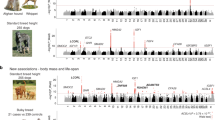Abstract
Using 27 body measurements, we have identified 13 breed-defining metrics for 109 of 159 domestic dog breeds, most of which are recognized by the American Kennel Club (AKC). The data set included 1,155 dogs at least 1 year old (average 5.4 years), and for 53 breed populations, complete measurement data were collected from at least three males and three females. We demonstrate, first, that AKC breed standards are rigorously adhered to for most domestic breeds with little variation observed within breeds. Second, Rensch’s rule, which describes a scaling among taxa such that sexual dimorphism is greater among larger species if males are the larger sex, with less pronounced differences in male versus female body size in smaller species, is not maintained in domestic dog breeds because the proportional size difference between males and females of small and large breeds is essentially the same. Finally, principal components (PCs) analysis describes both the overall body size (PC1) and the shape (length versus width) of the skeleton (PC2). That the integrity of the data set is sufficiently rich to discern PCs has strong implications for mapping studies, suggesting that individual measurements may not be needed for genetic studies of morphologic traits, particularly in the case of breed-defining traits that are typically under strong selection. Rather, phenotypes derived from data sets such as these, collected at a fraction of the effort and cost, may be used to direct whole-genome association studies aimed at understanding the genetic basis of fixed morphologic phenotypes defining distinct dog breeds.







Similar content being viewed by others
References
American Kennel Club (1998) The complete dog book, 19th edn., revised edn. Howell Book House, New York
Bohonak AJ, van der Linde K (2004) RMA: software for reduced major axis regression, Java version. http://www.bio.sdsu.edu/pub/andy/RMA.html
Brewer D, Clark T, Phillips A (2001) Dogs in antiquity: anubis to cerberus, the origins of the domestic dog. Aris and Phillips, Warminster
Chase K, Carrier DR, Adler FR, Jarvik T, Ostrander EA et al (2002) Genetic basis for systems of skeletal quantitative traits: Principal component analysis of the canid skeleton. Proc Natl Acad Sci USA 99:9930–9935
Chase K, Carrier DR, Adler FR, Ostrander EA, Lark KG (2005) Interaction between the X chromosome and an autosome regulates size sexual dimorphism in Portuguese water dogs. Genome Res 15:1820–1824
Fairbairn DJ (1997) Allometry for sexual size dimorphism: pattern and process in the coevolution of body size in males and females. Annu Rev Ecol Syst 28:659–687
Jones P, Chase K, Martin A, Davern P, Ostrander EA et al (2008) Single-nucleotide-polymorphism-based association mapping of dog stereotypes. Genetics 179:1033–1044
Karlsson EK, Baranowska I, Wade CM, Salmon Hillbertz NH, Zody MC et al (2007) Efficient mapping of mendelian traits in dogs through genome-wide association. Nat Genet 39:1321–1328
Lark KG, Chase K, Carrier DR, Adler FR (2006) Genetic analysis of the canid skeleton: morphological loci in the Portuguese water dog population. In: Ostrander UGEA, Lindblad-Toh K (eds) The dog and its genome. Cold Spring Harbor Laboratory Press, Cold Spring Harbor, NY
Moody JA, Clark LA, Murphy KE (2006) Canine history and breed clubs. In: Ostrander UGEA, Lindblad-Toh K (eds) The dog and its genome. Cold Spring Harbor Laboratory Press, Cold Spring Harbor, NY
Ostrander EA, Kruglyak L (2000) Unleashing the canine genome. Genome Res 10:1271–1274
Parker HG, Kim LV, Sutter NB, Carlson S, Lorentzen TD et al (2004) Genetic structure of the purebred domestic dog. Science 304:1160–1164
Parker H, Kukekova A, Akey D, Goldstein Ol, Kirkness E et al (2007) Breed relationships facilitate fine mapping studies: a 7.8 Kb deletion cosegregates with collie eye anomaly across multiple dog breeds. Genome Res 17:1562–1571
Peres-Neto PR, Jackson DA, Somers KM (2004) How many principal components? stopping rules for determining the number of non-trivial axes revisited. Comput Stat Data Anal 49:974–997
Pollinger JP, Bustamante CD, Fledel-Alon A, Schmutz S, Gray MM et al (2005) Selective sweep mapping of genes with large phenotypic effects. Genome Res 15:1809–1819
Sutter NB, Bustamante CD, Chase K, Gray MM, Zhao K et al (2007) A single IGF1 allele is a major determinant of small size in dogs. Science 316:112–115
Wayne RK (1986a) Cranial morphology of domestic and wild canids: the influence of development on morphological change. Evolution 40:243–261
Wayne RK (1986b) Limb morphology of domestic and wild canids: the influence of development on morphologic change. J Morphol 187:301–319
Acknowledgments
We thank the hundreds of dog owners who collected measurements from their dogs or allowed us to collect measurements. We thank Barbara Hoopes for helpful discussion and Sean Davis for advice on R. We acknowledge the Intramural Program of the National Institutes of Health, the AKC Canine Health Foundation, and the Cornell College of Veterinary Medicine for their support.
Author information
Authors and Affiliations
Corresponding author
Electronic supplementary material
Below is the link to the electronic supplementary material.
Rights and permissions
About this article
Cite this article
Sutter, N.B., Mosher, D.S., Gray, M.M. et al. Morphometrics within dog breeds are highly reproducible and dispute Rensch’s rule. Mamm Genome 19, 713–723 (2008). https://doi.org/10.1007/s00335-008-9153-6
Received:
Accepted:
Published:
Issue Date:
DOI: https://doi.org/10.1007/s00335-008-9153-6




